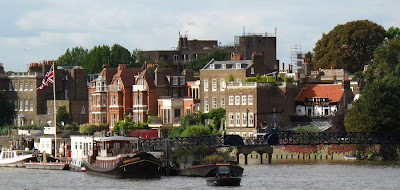In Pirton, we wondered if we had stepped into the set of Midsomer Murders (or in this case Late Summer Murders!), as the village clean up was dragging weeds out of the village pond. In true Midsomer Murder style, we expected Joyce to be there helping, and that one of the villagers should have dragged up a body during the cleanup.
Hitchin is more than a village, more a proper market town. The large pedestrainised market square has quite a European feel, with an outdoor cafe. From each corner of the square are streets full of lovely old buildings. This town did not appear to be suffering from small town depression, so common in other places. Shops were appealing and busy, and the church full of wonderful flower arrangements in anticipation of a concert.
Just down the road is Letchworth, a planned city only built just over 100 years ago in 1903. It was founded by Ebenezer Howard as the world's first Garden City – the concept was to build a city in an area of countryside which would help to make it self-sufficient for food; years ahead of the modern food-miles concept. The town is attractive in spacious planned way, unlike old towns which grew by degrees.
 The last stop was at Ashwell, the source of the River Cam, where it bubbles up on the edge of town. The town itself is full of wonderful old buildings, and a fascinating church which not only has the tallest spire in the county, but on the spire, the clock fitted in 1896 only has three faces,
The last stop was at Ashwell, the source of the River Cam, where it bubbles up on the edge of town. The town itself is full of wonderful old buildings, and a fascinating church which not only has the tallest spire in the county, but on the spire, the clock fitted in 1896 only has three faces, as the farmer on the north side complained that his farm workers would be distracted from their work if they could stop and watch this new feature!! What changes, people just find new things to complain about, especially new technology that might affect the workforce!
as the farmer on the north side complained that his farm workers would be distracted from their work if they could stop and watch this new feature!! What changes, people just find new things to complain about, especially new technology that might affect the workforce!














































